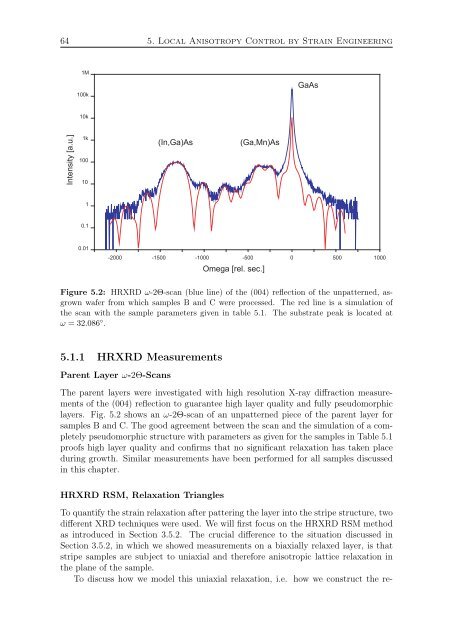Ferromagnetic (Ga,Mn)As Layers and ... - OPUS Würzburg
Ferromagnetic (Ga,Mn)As Layers and ... - OPUS Würzburg
Ferromagnetic (Ga,Mn)As Layers and ... - OPUS Würzburg
You also want an ePaper? Increase the reach of your titles
YUMPU automatically turns print PDFs into web optimized ePapers that Google loves.
64 5. Local Anisotropy Control by Strain Engineering<br />
1M<br />
100k<br />
<strong>Ga</strong><strong>As</strong><br />
10k<br />
Intensity [a.u.]<br />
1k<br />
100<br />
10<br />
(In,<strong>Ga</strong>)<strong>As</strong><br />
(<strong>Ga</strong>,<strong>Mn</strong>)<strong>As</strong><br />
1<br />
0.1<br />
0.01<br />
-2000 -1500<br />
-1000<br />
-500<br />
0<br />
500 1000<br />
Omega [rel. sec.]<br />
Figure 5.2: HRXRD ω-2Θ-scan (blue line) of the (004) reflection of the unpatterned, asgrown<br />
wafer from which samples B <strong>and</strong> C were processed. The red line is a simulation of<br />
the scan with the sample parameters given in table 5.1. The substrate peak is located at<br />
ω = 32.086 ◦ .<br />
5.1.1 HRXRD Measurements<br />
Parent Layer ω-2Θ-Scans<br />
The parent layers were investigated with high resolution X-ray diffraction measurements<br />
of the (004) reflection to guarantee high layer quality <strong>and</strong> fully pseudomorphic<br />
layers. Fig. 5.2 shows an ω-2Θ-scan of an unpatterned piece of the parent layer for<br />
samples B <strong>and</strong> C. The good agreement between the scan <strong>and</strong> the simulation of a completely<br />
pseudomorphic structure with parameters as given for the samples in Table 5.1<br />
proofs high layer quality <strong>and</strong> confirms that no significant relaxation has taken place<br />
during growth. Similar measurements have been performed for all samples discussed<br />
in this chapter.<br />
HRXRD RSM, Relaxation Triangles<br />
To quantify the strain relaxation after pattering the layer into the stripe structure, two<br />
different XRD techniques were used. We will first focus on the HRXRD RSM method<br />
as introduced in Section 3.5.2. The crucial difference to the situation discussed in<br />
Section 3.5.2, in which we showed measurements on a biaxially relaxed layer, is that<br />
stripe samples are subject to uniaxial <strong>and</strong> therefore anisotropic lattice relaxation in<br />
the plane of the sample.<br />
To discuss how we model this uniaxial relaxation, i.e. how we construct the re-
















